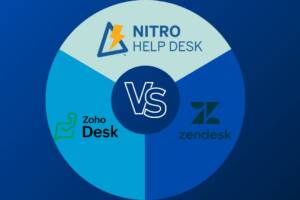H
At a Glance: Feature Comparison Table
| Feature / Platform | Zendesk | Zoho Desk | NITRO Help Desk |
|---|---|---|---|
| Microsoft 365 Integration | ❌ Limited via connectors | ✅ Outlook/Calendar only | ✅ Full integration with Microsoft 365, Teams, and SharePoint |
| Customization | ⚠️ Rigid, requires developers | ⚠️ Limited visual customization | ✅ Fully configurable via no-code/low-code tools |
| Pricing Transparency | ❌ Complex tiers, add-ons | ✅ Affordable plans | ✅ Clear, cost-effective licensing |
| Ease of Use | ⚠️ Steep learning curve | ✅ Simple interface | ✅ User-friendly and built within the Microsoft UI |
| Automation & AI | ✅ Good automation tools | ⚠️ Basic AI suggestions | ✅ Built-in AI & automation tools |
| Ideal For | Large enterprises | Small businesses | ✅ Small to mid-size orgs using Microsoft 365 |
| On-Premises Option | ❌ No | ❌ No | ✅ Yes, for GCC High and compliance-sensitive environments |
Real-World Scenarios
1. The Microsoft 365 Advantage
Let’s say your organization already uses Microsoft Teams for collaboration, SharePoint for intranet portals, and Outlook for communication. Implementing Zendesk or Zoho Desk means operating outside of that environment. You’ll constantly be switching tabs and managing siloed systems.
NITRO Help Desk, on the other hand, is built directly into Microsoft 365. You can:
-
Raise and resolve tickets directly within Teams
-
Track assets and approvals via SharePoint
-
Automate escalations using Power Automate
-
Maintain compliance with GCC and FedRAMP requirements (when applicable)
This seamless integration results in faster ticket resolution and a more unified IT ecosystem.
2. Cost Savings Without Cutting Corners
According to Software Advice, the average cost for a help desk platform can be around $150+/user/month. Zendesk and Zoho often seem affordable until you add integrations, custom workflows, or knowledge bases.
NITRO Help Desk’s pricing is straightforward and built for scaling within your existing Microsoft environment—eliminating the need to pay for redundant features or expensive connectors.
3. Built for IT Teams Who Want Control
If your IT department wants to tailor the system to your workflows, NITRO Help Desk provides unmatched flexibility through its low-code/no-code platform. Whether you’re customizing forms, creating approval flows, or designing dashboards, everything is configured without writing a single line of code.
Compare that to Zendesk, which often requires hiring developers to go beyond basic functionality.
Industry Insight: Help Desk Trends
-
85% of IT teams say integration with other systems is crucial for their help desk software (HDI, 2024).
-
Organizations using Microsoft 365-integrated help desks report a 27% increase in ticket resolution speed (Crow Canyon User Data, 2025).
-
70% of support teams experience better user adoption when the help desk mirrors tools their organization already uses, like SharePoint or Teams (Gartner, 2024).
Final Verdict: Why NITRO Help Desk Wins
If you’re in a Microsoft 365 ecosystem, NITRO Help Desk is simply the smarter, more efficient, and cost-effective choice.
While Zendesk is powerful and Zoho Desk is user-friendly, NITRO Help Desk is purpose-built for organizations that live in Microsoft 365. It removes the friction of managing multiple platforms and delivers a modern, AI-powered support experience from directly within the tools your team already uses.
Ready to explore the future of help desks within Microsoft 365?
Book a 15-minute call to see NITRO Help Desk in action and discover how it can cut support time, reduce costs, and improve user satisfaction.

